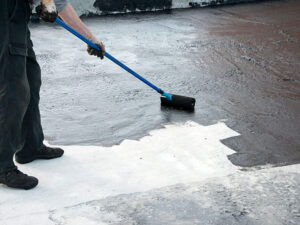Damp and water damage could be among the worst nightmares of any home and building owner. These conditions allow microbes to survive inside the structure and molds to build up on walls, ceilings, and floors, making a building incapable of sustaining a healthy lifestyle. Now that it’s still summer in the U.S., it should be the perfect timing to waterproof the walls. And if you haven’t added that in your builders schedule yet, it’s high time to contact a painting subcontractor and discuss how you can waterproof your new construction project.
The U.S. isn’t specifically a damp country, unlike the regions in the UK. However, being a place that experiences four seasons, every building and house owner should think about how to survive the moisture brought about by the changing climate and weather.
Waterproofing a structure is the best way to protect it from damages caused by changing seasons. It acts as a barrier against water and moisture and effectively prevents molds from building up on the exterior and interior walls. There’s a wide range of products available in the market for waterproofing buildings, but one of the most commonly used solutions is waterproof paint. It works on almost any surface, including cement, tiles, masonry, brick, wood, and more.
To help you protect your walls, basement, ceilings, roofs, and more, we’re going to discuss foolproof waterproofing tips and the right kind of waterproofing paints to use on different surfaces parts of your building.
Tips for Waterproofing Buildings
It is a painting subcontractor’s job to introduce you to the different waterproofing solutions that can help you lengthen your building project’s life. From walls down to the floors or up to the roof, there’s a right waterproofing solution suitable for each building area. Some tricks you should know about include:
1. Basement Waterproofing
When the worst rainy season hits your local area and your building isn’t protected by any kind of waterproofing, the tendency is that water seeps through the wall and collects on the floor. You will see leaks coming from the pipes too. The same scenario can happen during the winter when the air is moister and when it’s foggy. The challenge now is to stop moisture absorption by the walls and floors.
Obviously, the solution here is waterproofing, and it is the painting subcontractor’s job to provide you with the best remedy for protecting your walls and floors. But before they recommend any solution, waterproofing experts first need to inspect the moisture level in the soil where your building is situated. Waterproofing experts would often recommend using watertight waterproofing paint as a protective layer for the exterior walls to prevent mildew, efflorescence, and damp from seeping in.
Other Tricks
When there is a sloping land towards your home, you are more likely to experience graver water issues inside your building. That’s because the gravitational force leads water from the top ground to flow through your building’s basement area. So ask for the most notorious waterproofing solution to protect your basement as it can greatly affect your foundation’s strength.
Basement windows need to be installed with window sealing to prevent water from coming inside your building. Poor ventilation is another problem as it can expedite the formation of moisture on the walls. Be sure to maintain the right temperature inside the building during the cold seasons and use a dehumidifier during the hot seasons.
2. Roof Waterproofing
The roof is another entrance of moisture through the building. Water formation on the roof can damage the roof and can penetrate through the ceiling. Eventually, it can cause the ceiling to collapse, and that would be a bigger problem.
According to surveys, cracks are the main causes of dripping in the building. To prevent seeing a waterfall inside the building, you also need to protect your roof with waterproofing paint.
The roof withstands all kinds of weather and is directly exposed to heat and cold. Due to the changes in the weather, it can crack over time. So, roofing subcontractors recommend painting the roof with an elastomeric coating to make it stronger against temperature variations.
Other Tricks
Some home and building owners would place a chimney, ventilation, or lightboxes on their roofs. They should then be sealed during construction. Meanwhile, if you have tiles on your flooring, you can use polyurethane sealant between the tiles so it won’t be extremely damaged when the roof suddenly fails, and water comes in the building.
Waterproofing During Construction Steps
It can be overwhelming to manage a project most, especially when it is a big one. But this shouldn’t be a reason to neglect an important detail that will contribute to your building’s longer lifespan like waterproofing. That said, here are steps you can observe for waterproofing your project during construction:
1. Check Building for Cracks and Seal Them
The walls of the building will eventually develop cracks. These cracks will make the building weak and can be an entry point of rainwater and moisture. To prevent that from happening, you need to spot cracks that are developed as early as the construction phase that may be caused by poor masonry work. Before painting the building, apply putty before the rainy season if the builders’ schedule extends up to the rainy days.
2. Apply Exterior Paint
Apart from making a building visually appealing, exterior paint serves as a barrier for the structure, protecting it from external forces, most especially from water, fog, snow, and moisture. So whether you are painting a stone, brick, wood, metal, concrete, or vinyl surface, choose the right paint that can defend your project. Consult with your painting subcontractor to know which waterproofing paint is best for your building.
3. Caulking
The windows can be the inlet and outlet of air and water in a building. Hence, all windows should be properly sealed during construction, even if they are non-working windows. Find quality caulking services that will last up to 7 years to save from costly re-caulking every year.
4. Apply Plaster Additive
Besides using exterior paint, you can also ask your subcontractor to add plasters to make your walls more solid and moisture-resistant. Most plasters have waterproofing characteristics, but you can still add a waterproofing admixture to make the plaster more effective at blocking water and moisture.
5. Apply Waterproofing Paint
Inside your building, you can use a waterproofing paint to support the exterior paint’s protection. Use enough volume of paint to create an impenetrable barrier against water and moisture, trying to infiltrate your building.
6. Test the Waterproofed Wall
Conduct a water tightness test after waterproofing the building to know whether the products your painting subcontractor recommended are effective. In doing a water tightness test, water will be sprayed on the wall for hours. If no moisture is detected by the moisture meter, then your building passes the water tightness test, and it only means that your waterproofing products are reliable.
Choosing Waterproofing Paint for Your Construction Project
Waterproofing paints come in different types. It is best to consult with your painting subcontractor to know which one is best to use on your building’s different surfaces. Here are some types to consider:
1. Masonry Waterproofing Paint
This kind of waterproofing paint is often used on roofs and is made of latex and ceramic paints. This paint is one of the most recommended solutions by roofers worldwide as it can be applied on any roof surface. It is also quick at absorbing liquid solutions never to allow rainwater to penetrate inside the building through the roof. Furthermore, it makes the roof dirt-resistant hence making it more durable.
Other projects use the masonry paint on bricks, stones, and concrete blocks for an extra layer of protection.
2. Epoxy Waterproofing Paint
Epoxy waterproofing paint is made from poly-epoxides or resin. It is mostly used on roofs too. Applying it on the roof can make it resistant to chemicals, concentric acids, and water.
3. Acrylic Waterproofing Paint
The last type we’re discussing in this blog is the acrylic waterproofing paint. This type of paint solution can be used on roofs, walls, and other building areas. Use a primer first before applying the acrylic paint to double the durability of the building. It increases a building’s resistance against water, hence expelling rain. What’s great about acrylic paint is that it is non-toxic in nature, odor-free, easy to apply, and quick to dry.
Final Words
To manage a project in construction can be daunting, but when you have the right solutions and subcontractors, delivering an impressive project won’t be impossible. This is especially true with waterproofing a building. The various waterproofing technology that comes in the form of paint is exceptionally amazing at making buildings water and moisture resistant. Some of these paints are even quick to dry like the Acrylic Waterproofing paint, so it shouldn’t go in the way of your crew schedule. Whether you are in the sunny West Coast or Rainy East Coast, waterproofing is an essential strategy in making a building last longer.





